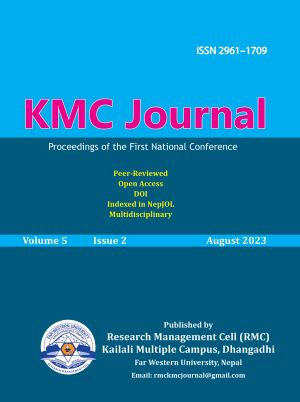First Principle Study on Structural, Electronic, Vibrational Properties and Molecular Docking Study of Tyramine
DOI:
https://doi.org/10.3126/kmcj.v5i2.58241Keywords:
DFT, tyramine, spectroscopy, neuromodulator, binding affinityAbstract
First principle study of cyclic compound has a great interest because their products are very much useful in biological and clinical applications. In this work, Density functional theory (DFT) and Time dependent DFT calculations have been performed to study structural, electronic and vibrational properties of Tyramine (a neuromodulator) at B3LYP/3-21G level employing Gaussian 09 software. All the theoretical calculations were carried out to study the equilibrium geometries, vibrational spectra, molecular electrostatic potential (MEP), highest occupied molecular orbital (HOMO), lowest unoccupied molecular orbital (LUMO) and UV-Vis spectra of the title compound. Also, the molecular docking analysis of Tyramine against two different proteins (Trace amine-associated receptor 1 and Dopamine D2 receptor) was carried out using AutoDock Vina. The scaled values of calculated vibrational frequencies were used for vibrational assignments on the basis of the potential energy distribution (PED). The structure activity relation has been interpreted by mapping MEP and Time dependent DFT method has been adopted to elucidate electronic properties. Graphical representation of frontier molecular orbital for both gaseous and solvent phase provides valuable insight into the nature of reactivity, stability and some of the structural and physical properties of the title molecule. Also, the calculated HOMO and LUMO energy values show that the charge transfer occurs within the molecule. Further, the title molecule shows good potentiality for binding against Trace amine-associated receptor 1 (1TQN) with binding affinity -6 kcal/mol The binding site of the Tyramine is found to be amine (NH2) group.
Downloads
Downloads
Published
How to Cite
Issue
Section
License

This work is licensed under a Creative Commons Attribution-NonCommercial 4.0 International License.
This license allows reusers to distribute, remix, adapt, and build upon the material in any medium or format for noncommercial purposes only, and only so long as attribution is given to the creator.




